The History
St Oswald’s – the Early Years 1937 to 1962
Click on the pictures to expand.
First of all, a bit of background on Croxley Green.
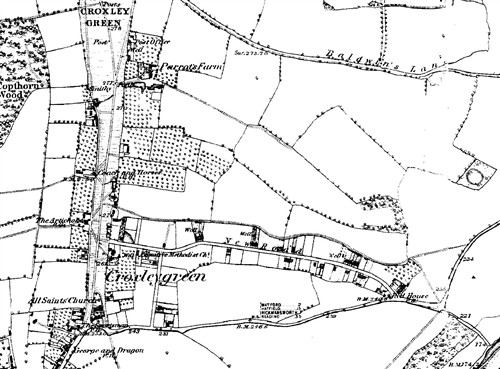 Although Dickinson’s Paper Mill arrived here in 1830, it was a small scale operation until the late 1870s and little changed until long after New Road was built in the 1860s – in 1868 the population of Croxley was only 1,000 and even by 1881 (as can be seen in this map) there was little housing apart from a few cottages plus some big houses clustered round the Green. Dickinson's purchased land south of New Road and built housing for workers in Mill Square (now Dickinson’s Square. By now the nucleus of Croxley Green was firmly in place although there was still no development south of Watford Road or north of New Rd. nor, indeed, any roads until you got to the track which was Baldwins Lane.
Although Dickinson’s Paper Mill arrived here in 1830, it was a small scale operation until the late 1870s and little changed until long after New Road was built in the 1860s – in 1868 the population of Croxley was only 1,000 and even by 1881 (as can be seen in this map) there was little housing apart from a few cottages plus some big houses clustered round the Green. Dickinson's purchased land south of New Road and built housing for workers in Mill Square (now Dickinson’s Square. By now the nucleus of Croxley Green was firmly in place although there was still no development south of Watford Road or north of New Rd. nor, indeed, any roads until you got to the track which was Baldwins Lane.
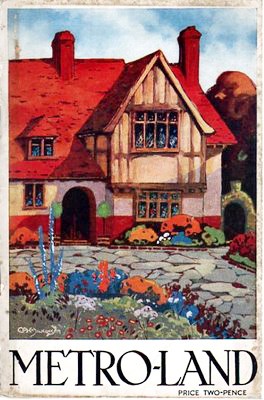 After WW1 the empty spaces to the north were gradually infilled accelerating with the arrival of the Metropolitan Line and the 1930s flight to the suburbs. Some may remember the slogan “Live in Metroland” engraved on the door handles of the old brown Met trains – so beloved of John Betjeman.
After WW1 the empty spaces to the north were gradually infilled accelerating with the arrival of the Metropolitan Line and the 1930s flight to the suburbs. Some may remember the slogan “Live in Metroland” engraved on the door handles of the old brown Met trains – so beloved of John Betjeman.
There was only one Anglican church in Croxley and it is largely down to the vision of one man, Percy Langdon, the then vicar of All Saints, that steps were taken in the mid 30s to cater for the spiritual needs of the new residents. By September 1936 a site for building a combined church and hall had been acquired and plans agreed.
An appeal was made for donations for furnishings, including two types of chair– you can’t put ‘bums on seats’ if there are no seats!. Some cost 4/8d (24p) and others 5/6d (28p) – these were folding chairs (as the hall part of the combined building had to be cleared each Sunday night). They were initially called “collapsible” chairs – but apparently nobody wanted to buy chairs that collapsed when you sat on them. So they had to call them something different!
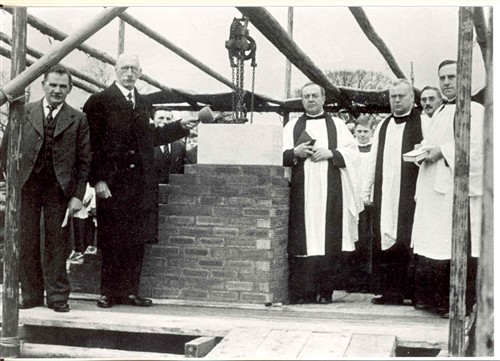
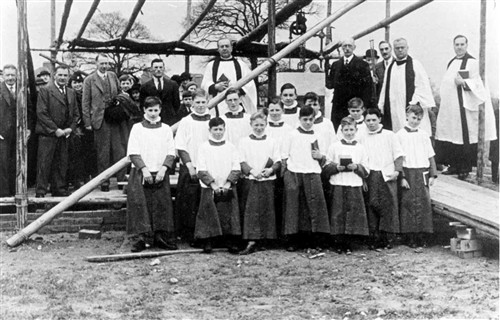 By April 1937 the foundation stone was laid with the architect and various local dignitaries in attendance, as well as All Saints choir.
By April 1937 the foundation stone was laid with the architect and various local dignitaries in attendance, as well as All Saints choir.
Some of the bricks were laid by residents in exchange for a donation of one shilling (5p) a brick . Few women wore slacks then and to preserve their modesty, ladies laid their bricks in the lower courses.
By October 1937 work was complete – a mere 18 months after plans were agreed. On the first Sunday there were 30 communicants, 9 children were baptised, and 103 joined the Sunday School – there was of course a high proportion of young families on the new estates.
On a normal Sunday the services were:
Holy Communion at 8.00 a.m.,
Children at 10,
Matins at 11, and
Evensong at 6.30.
As a combined church and hall, the inside was rather different then: there were chairs, not pews, for both choir and congregation and Instead of an organ, there was a piano. Instead of being carpeted, the floor of the chancel was wooden planks,
The building was divided into two by partitions, the lower part of which could be folded back, or removed. The main building was used as a hall during the week, and the screens removed for Sunday services. This also meant that all the chairs had to be put out on Saturday night and stacked away on Sunday night, hence the need for the ‘collapsible’ chairs. There was no baptistry then – in its place there was a small raised stage, on which a variety of concerts, and other entertainments took place.
St Oswald’s is said to be the first (and probably the only) church in the country designed so that Badminton could be played in it.- and to prove it, there is a rather grubby shuttlecock which has been lying on one of the rafters for about 60 years.
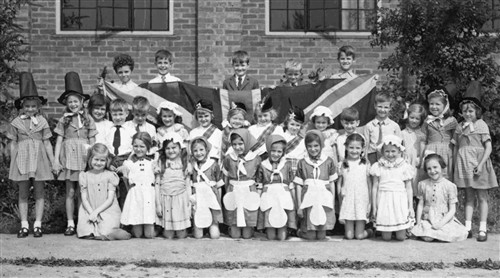 Children from schools evacuated from London were taught during the week in our hall, forming the first Malvern Way school (now a few yards distant).
Children from schools evacuated from London were taught during the week in our hall, forming the first Malvern Way school (now a few yards distant).
Croxley Green was spared much of the bombing suffered by London and other cities, but food was dull and some things were in short supply – eggs, butter, sweets – but we were never really hungry The Battle of Britain took place high overhead and of course from time to time we were sent home early from school as the All Clear sirens let us out from the shelters. Some local families were of course badly affected by the war – not only were their menfolk away in the forces, but some lost relatives – the son of members of our congregation was killed in action in Africa in 1943, and his parents donated our processional cross.
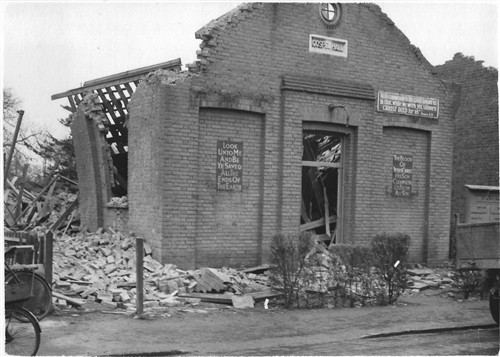
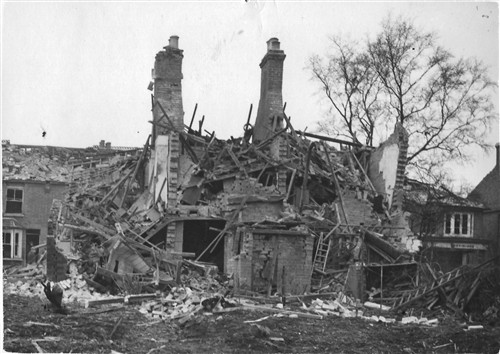 In 1940 a large part of All Saints church was damaged by a parachute mine, probably dropped at random by an enemy plane that had lost its way, and in 1944 the Gospel Hall at the top of Scots Hill and some cottages were destroyed by bombs; happily there were no fatalities, but there were some serious injuries.
In 1940 a large part of All Saints church was damaged by a parachute mine, probably dropped at random by an enemy plane that had lost its way, and in 1944 the Gospel Hall at the top of Scots Hill and some cottages were destroyed by bombs; happily there were no fatalities, but there were some serious injuries.
There were Youth Clubs at both churches, and these grew considerably after the arrival of Raymond Wilkinson as curate at All Saints. who started to produce Youth Club Gilbert and Sullivan operettas, the first being the Mikado in 1943 – seen here with Raymond Wilkinson as the Mikado, the Vicar of All Saints)as Pooh Bah, and our Choirmistress as Katisha.
 The war ended in 1945, and a party was held in the hall for the children; in the picture you can see the removable screens and the ‘collapsible’ chairs mentioned earlier. In 1946 we gained considerable independence from All Saints and Raymond Wilkinson became our Priest in Charge As well as the Youth Fellowship, other groups were started – an Adult Fellowship, Mothers’ Union, Guides & Brownies, and a Church Lads Brigade.
The war ended in 1945, and a party was held in the hall for the children; in the picture you can see the removable screens and the ‘collapsible’ chairs mentioned earlier. In 1946 we gained considerable independence from All Saints and Raymond Wilkinson became our Priest in Charge As well as the Youth Fellowship, other groups were started – an Adult Fellowship, Mothers’ Union, Guides & Brownies, and a Church Lads Brigade.
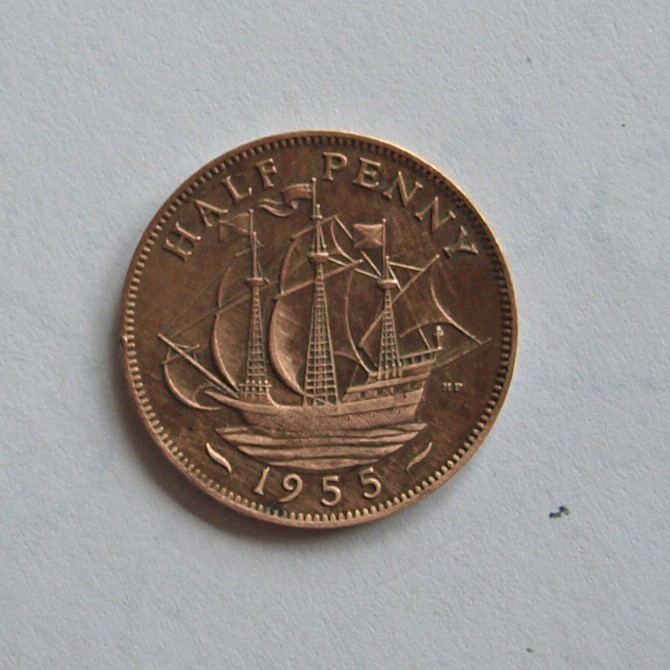 In the mid-1940s we planned to build a separate new church, with the existing building remaining as a church hall. To that end we bought land (now occupied by the Vicarage, some houses in Baldwins Lane, and Shaftesbury Court) for £2,200. One fundraising effort was for the children to collect Ship Halfpennies (they had a ship on the reverse) and they eventually collected 72,602 of them – no mean achievement. Sunday school took place on both Sunday morning and afternoon and on one occasion there were around 250 children & adults on one of their seaside outings. As a new church we were always on the lookout for new items – preferably free of charge, and in 1948 Raymond Wilkinson and noticed an old font in a churchyard, which served as a sharpening stone for the gardener’s sickle and this was installed here after some refurbishing to remove the grooves made by the sickle.
In the mid-1940s we planned to build a separate new church, with the existing building remaining as a church hall. To that end we bought land (now occupied by the Vicarage, some houses in Baldwins Lane, and Shaftesbury Court) for £2,200. One fundraising effort was for the children to collect Ship Halfpennies (they had a ship on the reverse) and they eventually collected 72,602 of them – no mean achievement. Sunday school took place on both Sunday morning and afternoon and on one occasion there were around 250 children & adults on one of their seaside outings. As a new church we were always on the lookout for new items – preferably free of charge, and in 1948 Raymond Wilkinson and noticed an old font in a churchyard, which served as a sharpening stone for the gardener’s sickle and this was installed here after some refurbishing to remove the grooves made by the sickle.
In the absence of TV much of our entertainment was home grown and in addition to the Youth Club Gilbert & Sullivan productions plays were put on, and concerts with a variety of church groups doing a ‘turn’ – these Gang shows were a popular annual event for some time. We relied a lot on Jumble sales and bazaars for fundraising in the 1950s and 1960s, when most St Oswald’s families tended to have more time than money to spare.
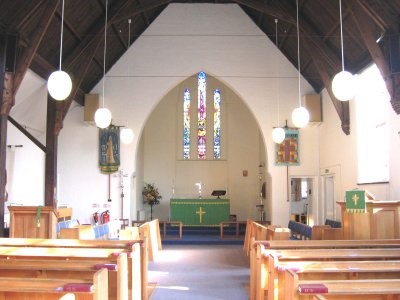 We were now 21 years old and, if we were to develop, St Oswald’s had to provide a house for the incumbent, and replace the dual-purpose building with separate buildings for church and hall. Plans to achieve this went ahead rapidly from now on. We sold part of the land bought in 1944 to finance the Vicarage, and help towards the cost of a new hall - which was opened in January 1961. Work could now be started on converting the combined church and hall - chairs were replaced with pews and carpet laid down the aisle. We now had in place a Vicarage, a church, and a hall – all the essentials for becoming a parish separate from All Saints, and in January 1962 the Bishop of Bedford consecrated St Oswald’s as a parish church.
We were now 21 years old and, if we were to develop, St Oswald’s had to provide a house for the incumbent, and replace the dual-purpose building with separate buildings for church and hall. Plans to achieve this went ahead rapidly from now on. We sold part of the land bought in 1944 to finance the Vicarage, and help towards the cost of a new hall - which was opened in January 1961. Work could now be started on converting the combined church and hall - chairs were replaced with pews and carpet laid down the aisle. We now had in place a Vicarage, a church, and a hall – all the essentials for becoming a parish separate from All Saints, and in January 1962 the Bishop of Bedford consecrated St Oswald’s as a parish church.
Just under 25 years after the foundation stone was laid in May 1937 St Oswald’s now looked very much the same as it does today.